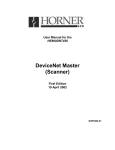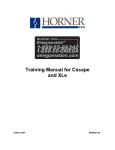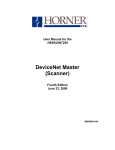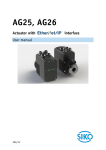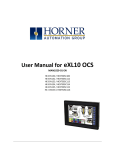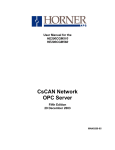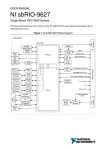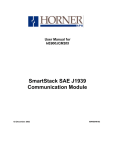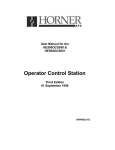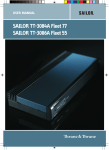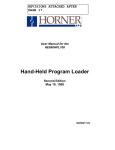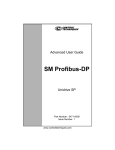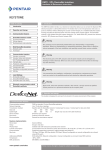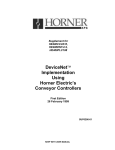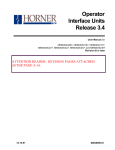Download XL - DeviceNet Master
Transcript
User Manual for the XL Series DeviceNet Master OCS XL - DeviceNet Master MAN0901- 01 PREFACE MAN0901 - 01 PREFACE This manual explains how to use the Horner APG’s DeviceNet Master. Copyright (C) 2002 Horner APG, LLC. S9. S. State Avenue, Indianapolis, Indiana 46201. All rights reserved. No part of this publication may be reproduced, transmitted, transcribed, stored in a retrieval system, or translated into any language or computer language, in any form by any means, electronic, mechanical, magnetic, optical, chemical, manual or otherwise, without the prior agreement and written permission of Horner APG, LLC. All software described in this document or media is also copyrighted material subject to the terms and conditions of the Horner Software License Agreement. Information in this document is subject to change without notice and does not represent a commitment on the part of Horner APG, LLC. DeviceNet is a trademark of Open DeviceNet Vendors Association (ODVA). Windows and Windows-95 are trademarks of Microsoft Corporation SmartStack, Cscape, and CsCAN are trademarks of Horner APG, LLC. For user manual updates, contact Horner APG, Technical Support Division at the following locations: North America: (317) 916-4274 www.heapg.com Email: [email protected] Europe: (+) 353-21-4321-266 www.horner-apg.com Email: [email protected] 4/6/2009 Page 2 of 36 ECN # 956 MAN0901 – 01 WARRANTY AND LIABILITY LIMITED WARRANTY AND LIMITATION OF LIABILITY Horner APG, LLC. ("HE") warrants to the original purchaser that the DeviceNet Master manufactured by HE is free from defects in material and workmanship under normal use and service. The obligation of HE under this warranty shall be limited to the repair or exchange of any part or parts which may prove defective under normal use and service within two (2) years from the date of manufacture or eighteen (18) months from the date of installation by the original purchaser whichever occurs first, such defect to be disclosed to the satisfaction of HE after examination by HE of the allegedly defective part or parts. THIS WARRANTY IS EXPRESSLY IN LIEU OF ALL OTHER WARRANTIES EXPRESSED OR IMPLIED INCLUDING THE WARRANTIES OF MERCHANTABILITY AND FITNESS FOR USE AND OF ALL OTHER OBLIGATIONS OR LIABILITIES AND HE NEITHER ASSUMES, NOR AUTHORIZES ANY OTHER PERSON TO ASSUME FOR HE, ANY OTHER LIABILITY IN CONNECTION WITH THE SALE OF THIS DEVICENET MASTER. THIS WARRANTY SHALL NOT APPLY TO THIS DEVICENET MASTER OR ANY PART THEREOF WHICH HAS BEEN SUBJECT TO ACCIDENT, NEGLIGENCE, ALTERATION, ABUSE, OR MISUSE. HE MAKES NO WARRANTY WHATSOEVER IN RESPECT TO ACCESSORIES OR PARTS NOT SUPPLIED BY HE. THE TERM "ORIGINAL PURCHASER", AS USED IN THIS WARRANTY, SHALL BE DEEMED TO MEAN THAT PERSON FOR WHOM THE DEVICENET MASTER IS ORIGINALLY INSTALLED. THIS WARRANTY SHALL APPLY ONLY WITHIN THE BOUNDARIES OF THE CONTINENTAL UNITED STATES. In no event, whether as a result of breach of contract, warranty, tort (including negligence) or otherwise, shall HE or its suppliers be liable of any special, consequential, incidental or penal damages including, but not limited to, loss of profit or revenues, loss of use of the products or any associated equipment, damage to associated equipment, cost of capital, cost of substitute products, facilities, services or replacement power, down time costs, or claims of original purchaser's customers for such damages. To obtain warranty service, return the product to your distributor with a description of the problem, proof of purchase, post paid, insured and in a suitable package. ABOUT PROGRAMMING EXAMPLES Any example programs and program segments in this manual or provided on accompanying diskettes are included solely for illustrative purposes. Due to the many variables and requirements associated with any particular installation, Horner APG cannot assume responsibility or liability for actual use based on the examples and diagrams. It is the sole responsibility of the system designer utilizing the DeviceNet Master to appropriately design the end system, to appropriately integrate the DeviceNet Master and to make safety provisions for the end equipment as is usual and customary in industrial applications as defined in any codes or standards which apply. It assumed that the system designer is familiar with OCS programming and configuration. Note: The programming examples shown in this manual are for illustrative purposes only. Proper machine operation is the sole responsibility of the system integrator. TABLE OF CONTENTS MAN0901 – 01 TABLE OF CONTENTS PREFACE........................................................................................................................................ 2 LIMITED WARRANTY AND LIMITATION OF LIABILITY ............................................................. 3 ABOUT PROGRAMMING EXAMPLES.......................................................................................... 3 CHAPTER 1: INTRODUCTION ..................................................................................................... 5 1.1 Overview ........................................................................................................................... 5 1.2 XL - DeviceNet Features................................................................................................... 5 1.3 Technical Specifications ................................................................................................... 5 1.4 Connectors........................................................................................................................ 6 1.4.1 DeviceNet I/O Connector........................................................................................... 6 CHAPTER 2: DeviceNet OCS RELATIONSHIPS ........................................................................ 7 2.1 General ............................................................................................................................. 7 2.2 Module to OCS Register Mapping .................................................................................... 7 2.3 Node to OCS Register Mapping ....................................................................................... 7 2.4 Message Packets and Fragmentation .............................................................................. 7 2.5 Physical Limitations........................................................................................................... 7 2.6 Data Assemblies ............................................................................................................... 8 2.7 XL - DeviceNet Configuration Introduction ....................................................................... 8 2.8 DeviceNet Node Priority and Implications ...................................................................... 10 2.9 Fault Table ...................................................................................................................... 11 CHAPTER 3: XL - DeviceNet REGISTER REQUIREMENTS .................................................... 13 CHAPTER 4: EXPLICIT MESSAGING USING XL - DeviceNet................................................. 17 4.1 General ........................................................................................................................... 17 4.2 Building Explicit Messages ............................................................................................. 17 4.3 How to Interpret Explicit Response Messages ............................................................... 18 4.4 Explicit Message Errors .................................................................................................. 19 CHAPTER 5: CONFIGURATION ................................................................................................ 21 5.1 General ........................................................................................................................... 21 5.2 Configuration................................................................................................................... 21 5.2.1 Select the Module to be configured ......................................................................... 21 5.2.2 Configure the Module .............................................................................................. 22 5.2.3 Creating the network configuration.......................................................................... 23 CHAPTER 6: DEVELOPING USER SOFTWARE ...................................................................... 27 6.1 Software Support for the Polled Connection................................................................... 27 APPENDIX A: XL - DeviceNet NETWORK OPERATION.......................................................... 29 A.1 Sequence of Events ........................................................................................................ 29 A.2 Establishing a Connection .............................................................................................. 29 A.3 Send a Polled Message .................................................................................................. 29 A.4 Explicit NOPs .................................................................................................................. 29 APPENDIX B: DeviceNet TIMING .............................................................................................. 31 B.1 Message Packet Timing.................................................................................................. 31 B.2 Network Scan Time versus OCS Scan Time.................................................................. 31 APPENDIX C: DeviceNet ERROR CODES ................................................................................ 33 INDEX............................................................................................................................................ 35 TABLE OF FIGURES.................................................................................................................... 36 MAN0901 - 01 CH.1 CHAPTER 1: INTRODUCTION 1.1 Overview The XL - DeviceNet OCS provide DeviceNet Communication on CAN Port. It is an intelligent communication interface module. It allows OCS to supervise a DeviceNet network. Up to 63 slave devices can be connected. Depending on baud rate and the cable type used, the DeviceNet slave nodes can be located up to 1,500 feet (457.2 meters) from the OCS. XL - DeviceNet Polled data is mapped directly into the OCS’s %I, %Q, %AI and %AQ registers. Polled data is transferred between the OCS’s registers and the DeviceNet slave nodes without any user or ladder code intervention. The DeviceNet specification provides two methods of establishing communications between a scanner and its nodes. The first method makes use of the “Unconnected Message Manager” (UCMM) and the second is known as “Group 2 Only”. “Group 2 Only” is the simplest, because of its simplicity; many slave devices only support the “Group 2 Only” method. The XL - DeviceNet allows both of these methods to be used simultaneously. Any single DeviceNet slave device can be either a Group 2 Only node or a UCMM node, never both. A DeviceNet network can be made up of a mixture of “Group 2 Only” and UCMM” slave devices. 1.2 XL - DeviceNet Features The XL - DeviceNet supports the following DeviceNet features: • Baud Rates: 125K, 250K, and 500K, • UCMM protocol (Log on), • Group 2 Only protocol, • The Polled Connection, • Ladder Initiated Explicit Messaging (LIEM), • Fragmentation on both polled and explicit connections, • All four Message Body Formats under UCMM. 1.3 Technical Specifications Table 1.1 – XL - DeviceNet Specifications DeviceNet Network Specifications Parameter Minimum Maximum DeviceNet Power Voltage 11 25 DeviceNet Power Load 65 DeviceNet Signal Baud Rate 125 500 DeviceNet Signal Driver Fanout 0 63 OCS Power Load Specifications Parameter Minimum Maximum +5Vdc (LOGIC) 0 175 +24Vdc (RELAY) 0 0 +24Vdc (ISOLATED) 0 0 Cable Specifications Description Belden # DeviceNet "Thick" Cable 3082A One twisted pair for signal, 18 gauges, separately foil shielded. One twisted pair for power, 15 gauges, separately foil shielded. Overall foil/braid shield with 18 gauge drain. 8 Amps maximum power. Description Belden # DeviceNet "Thin" Cable 3084A 4/6/2009 Page 5 of 36 Units V mA KHz Devices Units mA mA mA ECN # 956 CH.1 MAN0901 - 01 One twisted pair for signal, 24 gauges, separately foil shielded. One twisted pair for power, 22 gauges, separately foil shielded. Overall foil/braid shield with 22 gauge drain. 3 amps maximum power. DeviceNet Cable Length vs Network Baud Rate Maximum Cable Distance Thick Cable Thin Cable 1640 Feet 328 Feet 820 Feet 328 Feet 328 Feet 328 Feet Maximum Drop Distance Per Drop Cumulative 20 Feet 512 Feet 20 Feet 256 Feet 20 Feet 128 Feet DeviceNet Baud Rate 125KHz 250KHz 500kHz DeviceNet Baud Rate 125KHz 250KHz 500kHz These specifications are subject to change without notice. See ODVA DeviceNet Specification, Volume 1, and Section 9.3 for complete DeviceNet cabling specifications. 1.4 Connectors 1.4.1 DeviceNet I/O Connector The DeviceNet I/O connector is located usually next to the Power connector for XL Series. It consists of a 5-pin removable screw terminal with the following terminal descriptions: Figure 1.1 – Port Connector Pin 1 2 3 4 5 DeviceNet I/O Connector Pinout Signal Signal Description VCAN Ground CN_L CAN Data Low SHLD Shield Ground CN_H CAN Data High V+ No Connect Direction In/Out In/Out - NOTE: - For Pin5, V+ (Shown as NC) can be landed on this Pin for convenience, but is not required. A user-supplied 121Ω ¼W 1% resistor is needed for termination at each end of the network cabling. Refer to the DeviceNet cabling specifications for proper location of the terminating resistor. 4/6/2009 Page 6 of 36 ECN # 956 MAN0901 - 01 CH.2 CHAPTER 2: DeviceNet OCS RELATIONSHIPS 2.1 General Unless otherwise noted, all numeric radixes are in decimal. In a few cases the notation 0xhh is used to indicate Hexadecimal radix. 2.2 Module to OCS Register Mapping The XL - DeviceNet requires the use of four blocks of OCS registers. One block is defined in each of the OCS’s %I, %AI, %Q and %AQ register space. Through the use of the Cscape, the user can specify the starting register and the size of each of these four register blocks. Data from the XL - DeviceNet (and to the DeviceNet nodes) are passed in the %Q and %AQ registers. Data to the XL – DeviceNet are passed in the %I and %AI registers. With respect to the examples in this manual, the OCS register references are set to one. This simplifies our examples by assuming that all of the register reference assignments start at one. That is, the first %I, %Q, %AI and %AQ registers are assigned to OCS register %I1, %Q1, %AI1 and %AQ1. Although these register assignments can be placed anywhere within the OCS register space, we have made these assignments for simplicity sake. 2.3 Node to OCS Register Mapping Additionally, the XL - DeviceNet subdivides these register blocks providing individual sub-blocks to each DeviceNet node. This provides mapping between the OCS’s data registers and the data to and from each individual DeviceNet node. As a result, each node’s polled data is immediately available to the OCS ladder code by accessing the appropriate OCS register(s). Note that the node to OCS register assignments must be contained within the Module register definitions defined in Module to OCS Register Mapping discussed above. 2.4 Message Packets and Fragmentation A DeviceNet message packet can contain from 0 to 8 bytes of data. If more than 8 bytes of data are required, the message must be broken up into two or more packets or fragments. This is called fragmentation. The XL - DeviceNet handles this automatically, without any intervention by the user or the ladder program. Fragmentation works differently for Polled messages than explicit messages. In the case of Polled messages, each message fragment is sent to the receiving party one after the other as fast as possible. In the case of large explicit messages, the sender will send only the first packet. The sender then waits for an ACK message from the receiver. Upon receiving the ACK, the sender then transmits the next packet and waits for another ACK. This process repeats until all message fragments have been sent. This ACK process requires a considerable amount of time when compared to Polled messages. 2.5 Physical Limitations There are physical limits on the amount of data that can be transferred from / to the XL DeviceNet. This limit is 300 bytes of %I and %AI data and 300 bytes of %Q and %AQ data. The smallest data item that DeviceNet can handle is one byte. If an application requires only a single %Q output or command bit, a group of 8 %Qs must be allocated. The remaining 7 will be unused (or wasted). The same is true for bit type input data. 4/6/2009 Page 7 of 36 ECN # 956 CH.2 2.6 MAN0901 - 01 Data Assemblies For a Polled Connection, the data bytes within the DeviceNet messages must be sent and received in a predetermined order. This order is specified by “Data Assemblies”. Data Assemblies are published by the manufacturer of the DeviceNet node. To properly map the DeviceNet data, the data assemblies for each DeviceNet node must be available and understood. Consult data sheets from the DeviceNet node manufacturer for specific details on Data Assemblies. From the point of view of the OCS, all input is via %I and %AI registers and all output data is via %Q and %AQ registers. From the point of view of the DeviceNet nodes, all I/O is via streams of data bytes, known as Data Assemblies that they send and receive. In most DeviceNet nodes, the data assembly formats are fixed, in others they are configurable. Consult data sheets from the DeviceNet node manufacturer for details on Data Assemblies. The XL - DeviceNet accepts output data in the form of %Q and/or %AQ registers. It then translates this data into DeviceNet polled messages, and sends them to the node. The XL DeviceNet receives DeviceNet polled response messages from the addressed DeviceNet node, translates these DeviceNet messages and stores in the appropriate %I and/or %AI registers. The XL - DeviceNet allows up to 4 blocks of data to be concatenated to form a data assembly. Each block can be configured as either bit data or word data. The number of bits or words within each block is also configurable. Keep in mind that bits must be assigned in groups of 8 bits. The user can configure, for example, that the first block will contain 32 bits, the second block might contain 7 words, the third block might contain 8 bits and the forth block might contain 5 words. This would result in a data assembly that contains: 32 bits followed by 7 words followed by 8 bits followed by 5 words. This example results in a data assembly that contains 29 bytes. The user must define a data assembly for both the input and output data for each node on the network. 2.7 XL - DeviceNet Configuration Introduction Configuration of the XL - DeviceNet is performed using a PC running Cscape Software. There are a number of steps required in order to properly configure the XL - DeviceNet scanner module. These steps include: IO Configuration of XL - DeviceNet. Specify the XL - DeviceNet’s MACID. Specify the network baud rate. Specify the module’s first %I register number. Specify the module’s first %Q register number. Specify the module’s first %AI register number. Specify the module’s first %AQ register number. For each configured node, Specify the node’s first %I register number. Specify the node’s first %Q register number. Specify the node’s first %AI register number. Specify the node’s first %AQ register number. Specify the node’s Polled Expected Packet Rate for newly added node. Specify the node’s Minimum Polled Scan Time for newly added node. Specify the node’s Maximum Polled Response Time for newly added node. Specify the node’s Maximum Explicit Response Time for newly added node. Specify the node’s Input Data Assembly for newly added node. Specify the node’s Output Data Assembly for newly added node. Specify the node’s Polled Delay Time for newly added node. 4/6/2009 Page 8 of 36 ECN # 956 MAN0901 - 01 CH.2 Each of these items is briefly discussed below: IO Configuration of XL - DeviceNet. Refer to Chapter Five for configuration details. Specify the XL - DeviceNet’s MACID. This is the network address that the XL - DeviceNet will respond to. All nodes on the network, including the XL - DeviceNet must be configured with a unique MACID. Specify the network baud rate. This is the data bit rate at which all nodes on the network will operate. All nodes on the network must be configured to operate with the same baud rate. NOTE: User can change baud rate and node –id using XL device system menu. But when the power reset is done, these information’s are referred from flash stored configuration. Specify the module’s first %I register number. This entry specifies the first register in the block of %I registers that is assigned to the XL - DeviceNet module. Specify the module’s first %Q register number. This entry specifies the first register in the block of %Q registers that is assigned to the XL - DeviceNet module. Specify the module’s first %AI register number. This entry specifies the first register in the block of %AI registers that is assigned to the XL - DeviceNet module. Specify the module’s first %AQ register number. This entry specifies the first register in the block of %AQ registers that is assigned to the XL - DeviceNet module. Scan List. Before the XL - DeviceNet can communicate with any DeviceNet nodes, it must be configured with a Scan List which is present in the Setup window of a particular node. Input Data Assembly, Output Data Assembly, Time outs etc come under Scan List. The Scan List specifies which DeviceNet nodes to query. Only those nodes specified in the Scan List are considered to exist on the network. The XL - DeviceNet needs additional information about each of the nodes in the Scan List. For each node included in the Scan List: Specify the node’s first %I register number. This entry specifies the first register in the block of %I registers that are assigned to this node. Note that this block must be part of the larger block of %I registers assigned to the XL - DeviceNet above. Specify the node’s first %Q register number. This entry specifies the first register in the block of %Q registers that are assigned to this node. Note that this block must be part of the larger block of %Q registers assigned to the XL - DeviceNet above. Specify the node’s first %AI register number. This entry specifies the first register in the block of %AI registers that are assigned to this node. Note that this block must be part of the larger block of %AI registers assigned to the XL - DeviceNet above. Specify the node’s first %AQ register number. 4/6/2009 Page 9 of 36 ECN # 956 CH.2 MAN0901 - 01 This entry specifies the first register in the block of %AQ registers that are assigned to this node. Note that this block must be part of the larger block of %AQ registers assigned to the XL - DeviceNet above. Specify the node’s Polled Expected Packet Rate. This entry specifies the Expected Packet Rate that will be loaded into the node when a dialogue is established with the node. The node uses this number multiplied by four as an inactivity timer limit value. The node resets the inactivity timer each time it receives a polled request message from the XL - DeviceNet. If the timer expires the node will enter the timed-out state, effectively taking itself off-line. Specify the node’s Minimum Polled Scan Time. This is the minimum amount of time that the XL - DeviceNet will wait between sending polled requests to the node. In effect, this is the minimum time between consecutive scans to the node. Once the system is running, the actual polled scan time can be displayed through the fault table facility in real time. Specify the node’s Maximum Polled Response Time. This is the maximum time that the XL - DeviceNet will wait for a polled response from the node. If this timer expires, the node is taken off-line. Then at the next opportunity, the XL - DeviceNet will attempt to reconnect to the node. Specify the node’s Maximum Explicit Response Time. This is the maximum time that the XL - DeviceNet will wait for an explicit response from the node. If this timer expires, the node is taken off-line. Then at the next opportunity, the XL - DeviceNet will attempt to reconnect to the node. Specify the node’s Input Data Assembly. This item specifies the input data assembly for data received from the node. See section 3.6 for more details. Specify the node’s Output Data Assembly. This item specifies the output data assembly for data being sent to the node. See section 3.6 for more details. Specify the node’s Polled Delay Time. Some older slave nodes can not accept fragmented polled data packets sent at full speed, especially if the baud rate is 500KB. This entry instructs the XL - DeviceNet to insert a delay between polled fragmented packets addressed to this node. For most nodes, this entry should be set to zero. If required, try a value of 100 or 200. NOTE: DeviceNet scanning will take place only when device is in RUN mode and %Q1 (offset) bit is not set 2.8 DeviceNet Node Priority and Implications The XL - DeviceNet can carry on conversations with several DeviceNet nodes simultaneously. Because of this, DeviceNet Node Priorities become important. Within the scheme of CAN communications, there is a concept known as Arbitration. If two slaves begin to transmit CAN messages simultaneously, the slave with the smallest node address will win. The loser must immediately stop transmitting and try again later. This gives obvious priority to the slave with the lower node address. This can create problems if care is not taken in the assignment of node addresses. 4/6/2009 Page 10 of 36 ECN # 956 MAN0901 - 01 CH.2 Consideration should be given to the priorities of the individual nodes. In the design of most networks, there are usually a few nodes that require a higher priority than the rest. These nodes should be assigned the lower node addresses. 2.9 Fault Table The XL - DeviceNet provides a fault table that makes available the status of each node on the network. OCS registers %Q3, %Q4, %Q5, %AI5, and %AI6 (With respect to the base addresses set within the configuration) are used to provide a user interface into the fault table. The table has an entry for each DeviceNet node. The user is provided a single node window into the fault table. There are three command bits (%Q registers) to allow control over the fault table and the entry being displayed. Setting %Q3 causes the first node with a fault to be displayed. Setting %Q4 causes the next node with a fault to be displayed. If the node being displayed is the last node with a fault, then the first node with a fault will be displayed. Setting %Q5 causes all entries in the fault table to be cleared. Unpredictable results may occur if more than one of command bit %Q3, %Q4 or %Q5 is simultaneously set. The user is also provided two %AI registers that are used to display fault information about the indicated node. Each of these registers is broken into two bytes as indicated below: • The least significant byte of register %AI5 contains the Node Address of the fault data displayed in the next 3 bytes. • The most significant byte of register %AI5 contains the Fault Code that exists for the node indicated by the addressed node. The fault code can have the following values: 0. None. 1. Polled Scan Time. 2. Timeout waiting for an Explicit Fragmented Acknowledge Response Message. 3. Timeout waiting for an Allocate Explicit Connection Response Message. 4. Timeout waiting for an Allocate Polled connection Response Message. 5. Timeout waiting for a Get Polled Consumption Size Response Message. 6. Timeout waiting for a Get Polled Production Size Response Message. 7. Timeout waiting for a "NOP" Response Message. 8. Timeout waiting for a Polled Response Message. 9. Timeout waiting for a Set Polled Expected Packet Rate Response Message. 10. Timeout waiting for any other Explicit Response Message. 11. Unable to Establish an Explicit Connection. 12. Unable to Establish a Polled Connection. 13. Polled Consumption Size Error. 14. Polled Production Size Error. There are priorities involved with the fault code values. Priorities are assigned based on the numeric value of the individual fault codes. A higher number has a higher priority. If a code of 5 (Timeout waiting for a Get Polled Consumption Size Response Message) is being displayed, a lower priority code such as 2 (Timeout waiting for an Explicit Fragmented Acknowledge Response Message) will not displace the higher priority code. However, a lower priority fault code will be displaced by a higher priority code occurring. Fault code type 1 (Polled Scan Time) is really not a fault at all. Instead, if there is nothing else that needs to be displayed, The Polled scan time is displayed. This is the time from one Polled Command Message to the next, NOT the node's response time to a Polled Command Message. When looking at these polled scan times, keep in mind that the XL - DeviceNet will overlap Polled Command Messages. In other words, while waiting for a Polled Response Message from one node, a Polled Command Message will be sent to another node. It is possible on smaller networks that there could be a simultaneous Polled Response Message pending from each and every node on the network. The primary purpose of this technique is to more fully utilize the DeviceNet bandwidth. 4/6/2009 Page 11 of 36 ECN # 956 CH.2 MAN0901 - 01 • The most significant byte of register %AI6 contains Fault Data Byte 1. This byte takes on different meanings depending on the fault code: • If the fault code is Polled Consumption Size Error, this entry displays the consumption size as reported by the specified node. • If the fault code is Polled Production Size Error, this entry displays the production size as reported by the specified node. • If the fault code is Polled Scan Time, both bytes of this word (16 bit WORD value) reports the actual polled scan time for this node in milliseconds. • all other fault codes, not used. • The least significant byte of register %AI6 contains Fault Data Byte 2. This byte takes on different meanings depending on the fault code: • If fault code is Polled Consumption Size Error, this entry displays the consumption size as indicated by the XL - DeviceNet’s configuration file for the specified node. • If fault code is Polled Production Size Error, this entry displays the production size as indicated by the XL - DeviceNet’s configuration file for the specified node. • If the fault code is Polled Scan Time, both bytes of this word (16 bit WORD value) reports the actual polled scan time for this node. • all other fault codes, not used. Because it is possible that higher priority faults can be generated during system power up sequences, the following sequence should be followed to access the fault table: 1. Allow the system to run for a few seconds. 2. Clear the fault table. 3. Wait a few more seconds. 4. And finally, access the fault table. This causes the fault table to be refreshed with current data. Any preexisting high priority entries are eliminated in favor of the current lower priority data. 4/6/2009 Page 12 of 36 ECN # 956 MAN0901 - 01 CH.3 CHAPTER 3: XL - DeviceNet REGISTER REQUIREMENTS The XL - DeviceNet requires a number registers to be assigned to itself. The following tables define the XL - DeviceNet register requirements and definitions of these data assemblies (These registers are with respect to the base addresses assigned within the configuration): XL - DEVICENET REGISTER REQUIREMENTS Number of %Q’s 8 Number of %AQ’s 4 Number of %I’s 16 Number of %AI’s 6 XL - DeviceNet %Q REGISTER REQUIREMENTS %Q1 Stop DeviceNet Scanning %Q2 Send Explicit Message %Q3 Display the first node with a fault %Q4 Display the next node with a fault %Q5 Clear all faults %Q6-8 Reserved XL - DeviceNet %AQ REGISTER REQUIREMENTS %AQ1 Transmit Buffer First %R Number %AQ2 Transmit Buffer Size (In bytes) %AQ3 Receive Buffer First %R Number %AQ4 Receive Buffer Size (In bytes) XL - DeviceNet %I REGISTER REQUIREMENTS %I1 Someone is Off Line %I2 DeviceNet scanning is stopped %I3 Explicit Transaction Complete %I4 Explicit Error – Buffer Allocation Error %I5 Explicit Error – Can’t get %R buffer from OCS %I6 Explicit Error – Invalid MAC ID %I7 Explicit Error – Node Not Configured %I8 Explicit Error – Node not on-line %I9 Explicit Error – Operation timed out %I10 Explicit Error – Other DeviceNet Error %I11 Explicit Error – Receive Buffer Overrun %I12 Explicit Error – Can’t put %R buffer to OCS %I13 CAN Over Run Error %I14 CAN Bus Off Error %I15 CAN Bus Passive Error %I16 Invalid Configuration Error XL - DeviceNet %AI REGISTER REQUIREMENTS %AI1 On Line status, nodes 0-15 %AI2 On Line status, nodes 16-31 %AI3 On Line status, nodes 32-47 %AI4 On Line status, nodes 48-63 %AI5 LSB Fault Table Bytes 1 – Node Address %AI5 MSB Fault Table Bytes 2 – Fault Code %AI6 LSB Fault Table Bytes 3 %AI6 MSB Fault Table Bytes 4 4/6/2009 Page 13 of 36 ECN # 956 CH.3 MAN0901 - 01 %Q1 Stop DeviceNet Scanning Setting this bit causes the XL - DeviceNet to close or release all connections between itself and all DeviceNet nodes. No further communications will occur between the XL DeviceNet and the DeviceNet nodes until the Stop DeviceNet Scanning bit is cleared. While the scanning is stopped, the DeviceNet Scanning is Stopped bit %I2 bit will be set. %Q3 Display the first node with a fault Displays the fault data for the lowest addressed node that has an entry in the fault table. %Q4 Display the next node with a fault Displays the next node %Q5 Clear all fault codes Clears all entries in the fault table. %I1 Someone is Off Line This status bit indicated that one or more configured nodes are not on line. %I2 DeviceNet Scanning is Stopped This status bit indicates that the DeviceNet scanning is stopped as a result of the bit %Q1 Stop DeviceNet Scanning. %AI1 On Line Status of Nodes 00 - 15 %AI2 On Line Status of Nodes 16 - 31 %AI3 On Line Status of Nodes 32 - 47 %AI4 On Line Status of Nodes 48 - 63 These four %AI registers collectively contain 64 individual status bits. One bit is assigned to each of the 64 possible DeviceNet node addresses. Status bits for nodes 0 through 15 are mapped into the first %AI register. Status bits for nodes 16 through 31 are mapped into the second %AI register. Status bits for nodes 32 through 47 are mapped into the third %AI register. Status bits for nodes 48 through 63 are mapped into the fourth %AI register. The status bit for node 0 is placed in the least significant bit position of the first %AI register, with consecutively higher addressed nodes status bits being placed in the next higher bit positions. Each individual status bit is set TRUE if the corresponding DeviceNet node is On Line. On Line is defined as the node’s Polled connection being in the Established state and the node is communicating Polled data. %AI5 LSB – Fault Table Byte 1 – Node Address This byte contains the node address of the fault data displayed in the next 3 bytes. %AI5 MSB – Fault Table Byte 2 – Fault Code This byte indicates the type of fault that exists for the node indicated by the addressed node. The fault code can have the following values: 0. None. 1. Polled Scan Time. 2. Timeout waiting for an Explicit Fragmented Acknowledge Response Message. 3. Timeout waiting for an Allocate Explicit Connection Response Message. 4. Timeout waiting for an Allocate Polled connection Response Message. 5. Timeout waiting for a Get Polled Consumption Size Response Message. 6. Timeout waiting for a Get Polled Production Size Response Message. 7. Timeout waiting for a "NOP" Response Message. 8. Timeout waiting for a Polled Response Message. 9. Timeout waiting for a Set Polled Expected Packet Rate Response Message. 10. Timeout waiting for any other Explicit Response Message. 11. Unable to Establish an Explicit Connection. 4/6/2009 Page 14 of 36 ECN # 956 MAN0901 - 01 12. 13. 14. CH.3 Unable to Establish a Polled Connection. Polled Consumption Size Error. Polled Production Size Error. %AI6 MSB – Fault Table Byte 3 – Fault Data 1 • if the fault code is Polled consumption size error, this entry displays the consumption size as reported by the specified node. • if the fault code is Polled production size error, this entry displays the production size as reported by the specified node. • if the fault code is Polled scan time, both bytes of this word (16 bit WORD value) reports the actual polled scan time for this node in milliseconds. %AI6 LSB – Fault Table Byte 4 – Fault Data 2 • if fault code is Polled consumption size error, this entry displays the consumption size as indicated by the XL - DeviceNet 's configuration file for the specified node. • if fault code is Polled production size error, this entry displays the production size as indicated by the XL - DeviceNet 's configuration file for the specified node. • if the fault code is Polled scan time, both bytes of this word (16 bit WORD value) reports the actual polled scan time for this node. Note: Many DeviceNet nodes also provide additional diagnostic data within their individual data assemblies. 4/6/2009 Page 15 of 36 ECN # 956 CH.3 MAN0901 - 01 NOTES 4/6/2009 Page 16 of 36 ECN # 956 MAN0901 - 01 CH.4 CHAPTER 4: EXPLICIT MESSAGING USING XL - DeviceNet 4.1 General The XL - DeviceNet supports both POLLED and EXPLICIT connections. Explicit Messaging requires a great deal of overhead in XL - DeviceNet. Multiple scans may be required to access the required data in the XL - DeviceNet. As a result, Explicit Messages should be reserved for access to infrequently needed data, such as configuration or tuning parameters only. The sequence below presents a general description of the process that must be executed to service an explicit request. 1. The ladder code builds an explicit request message in a group of %R registers. 2. The ladder code plugs the start of and length of the transmit and receive buffers into four %AQ registers. The transmit and receive buffers must both be located in the %R register space of the OCS. 3. The ladder code then sets the “Send Explicit Message” command bit. 4. The XL - DeviceNet periodically checks the “Send Explicit Message” command bit. 5. If the “Send Explicit Message” command bit is set, processing of the explicit request begins. This command bit must remain on until success or error status is returned. 6. The four %AQ registers are examined and checked for validity. 7. The XL - DeviceNet requests the OCS to send the transmit buffer. 8. The XL - DeviceNet then checks the MACID contained in the transmit buffer. Several checks take place, MACID out-of-range, referenced node not configured and referenced node not On-line. 9. Then the message is formatted and sent to the referenced node. 10. When the response message is received, a check is made to see if the allocated receive buffer is large enough to accept the response message. 11. The message is then sent to the block of %R registers designated as the receive buffer. 12. The Explicit Transaction Complete bit is then set. 13. If there were any errors detected in any of the previous steps, the process is aborted and the appropriate error status bit along with the Explicit Transaction Complete bit are set. 4.2 Building Explicit Messages In the following example, let’s assume that we want to read the polled consumption size from the node at MACID 3, we also want to locate the transmit buffer at %R101, the receive buffer at %R51 and we will also allocate 20 bytes to the receive buffer. BYTE NUMBER 0 1 2 3 4 5 6 4/6/2009 REGISTER NUMBER R101 LSB R101 MSB R102 LSB R102 MSB R103 LSB R103 MSB R103 LSB DESCRIPTION MACID (Node Address) Service Code (Get Attribute Single) Class ID (Connection Class) Instance ID (Polled Connection) Attribute # (Consumption Size) Page 17 of 36 TRANSMIT BUFFER DATA 03 14 05 00 02 00 07 ECN # 956 CH.4 MAN0901 - 01 REGISTER %AQ1 %AQ2 %AQ3 %AQ4 DESCRIPTION Start of Transmit Buffer Number of Bytes to Transmit Start of Receive Buffer Receive Buffer Allocation Size VALUE 101 7 51 20 In the following example we want to write the polled expected packet rate to the node at MACID 3, we also want to locate the transmit buffer at %R101, the receive buffer at %R51, we will also allocate 20 bytes to the receive buffer. BYTE NUMBER 0 1 2 3 4 5 6 7 8 REGISTER NUMBER R101 LSB R101 MSB R102 LSB R102 MSB R103 LSB R103 MSB R104 LSB R104 MSB R105 LSB REGISTER %AQ1 %AQ2 %AQ3 %AQ4 4.3 DESCRIPTION MACID (Node Address) Service Code (Set Attribute Single) Class ID (Connection Class) Instance ID (Polled Connection) Attribute (Expected Packet Rate) Data Value Low Byte Data Value High Byte DESCRIPTION Start of Transmit Buffer Number of Bytes to Transmit Start of Receive Buffer Receive Buffer Allocation Size TRANSMIT BUFFER DATA 03 16 05 00 02 00 07 E8(Hex) 03 VALUE 101 9 51 20 How to Interpret Explicit Response Messages The normal, expected response from an Explicit Message is the Acknowledge Message: EXAMPLE BYTE DESCRIPTION NUMBER 0 Xx Number of bytes received 1 Xx 2 MACID 01 3 *Service Code 0x90(Hex) 4 Optional Data Xx Optional Data Xx Optional Data Xx n Optional Data Xx * Previously sent Service Code (0x10) + 0x80 Note: The Most Significant Bit in the Service Code byte is used as a Response Bit indicating that the command was properly received. [Service Code 0x10 + Response Bit 0x80 = 0x90]. If any extra data needs to be returned, that data will be placed into subsequent bytes. Note: The number of bytes received value is the number of bytes of the message placed in the receive buffer including the two bytes devoted to the number of bytes received. 4/6/2009 Page 18 of 36 ECN # 956 MAN0901 - 01 4.4 CH.4 Explicit Message Errors In the case that an Explicit Message requests a function that cannot be performed by the referenced node, an Explicit Error Message will be returned. An Explicit Error Message takes the following form: Byte Number Description 0 1 2 3 4 5 Number of bytes received MACID Service Code General Error Code Additional Error Code Example (values in HEX) 06 00 01 94 xx xx Word Offset Value (from example) %R1 0006 %R2 0x9401 %R3 xxxx An Error is indicated by a 0x94 in the service code byte. This indicates that the referenced node has detected an error and the two bytes following indicate the specifics to that error. The next byte indicates the General Error Code. The last byte contains an Additional Error Code to indicate additional information. See appendix C for a list of and definitions of General and Additional Error Codes. Many DeviceNet manufactures have defined vendor specific error codes. In this case the General error code will be in the range of 0xD0 to 0xFF (Vendor-specific Object and Class errors). In these cases the Additional error code can be anything. Consult the documentation from the node manufacture for more details. 4/6/2009 Page 19 of 36 ECN # 956 CH.4 MAN0901 - 01 NOTES 4/6/2009 Page 20 of 36 ECN # 956 MAN0901 - 01 CH.5 CHAPTER 5: CONFIGURATION 5.1 General Chapter Five describes the steps necessary to configure the XL - DeviceNet module. The procedures for using Cscape software are also described. 5.2 Configuration DeviceNet is inbuilt in all the XL series devices. With Cscape, however, OCS configuration is contained with the source code (.CSP) files. The OCS can be configured even if the OCS is not available. This is a great convenience when programming must start before the hardware has been received. 5.2.1 Select the Module to be configured First, invoke Cscape. From the Cscape Main Menu, select Controller | I/O Configure…. Select the controller to be configured. Figure 2.1 – Select the Module Slot If the OCS that is to be configured is available and connected to one of the COM ports, the Auto Config button can be used. Using this option will cause Cscape to read the OCS and display the modules that are connected to the OCS. 4/6/2009 Page 21 of 36 ECN # 956 CH.5 5.2.2 MAN0901 - 01 Configure the Module Now, Go to Programs Æ select Network Configuration. The DeviceNet network configuration utility will then open up. The first dialog that will appear is the Network Properties dialog. This dialog allows the user to set the starting Reference Addresses of the registers and Baud Rate of the network. The %I size, %AI size, %Q size, %AQ size, %I Ref Addr, %AI Ref Addr, %Q Ref Addr, and %AQ Ref Addr values are values with respect to the OCS that the XL - DeviceNet is running on. Select the Baud Rate drop down box to configure the baud rate for the XL DeviceNet. Once done configuring this screen, then click OK. Figure 3.2 – Network properties screen The network view of the configuration utility will appear. The right pane is the Network View where the user can build a visual representation of a network depicting the XL - DeviceNet Master and all slave nodes (devices). The nodes are configured in this view. 4/6/2009 Page 22 of 36 ECN # 956 MAN0901 - 01 CH.5 Figure 4.3 – Network View screen 5.2.3 Creating the network configuration The DeviceNet network can now be constructed within the network view display. Before constructing a network with this utility, it is recommended that one should use the following method to create the network: 1. Decide what baud rate the network will run at. This is needed for the XL - DeviceNet module configuration as well as the configuration of each individual DeviceNet node. All nodes including the XL - DeviceNet must be configured for the same baud rate. 2. Identify all devices (nodes) that are going to be a part of the network. 3. Is Data Assembly information available for each DeviceNet node in the network? This can be in the form of printed information in the manufactures manual or in the form of an EDS file provided by the manufacturer. Note that some EDS files do not provide the nodes’ polled consumption and production sizes. 4. Assign MACIDs (node addresses) to each DeviceNet node. The MACIDs assigned to each node is totally arbitrary. The only thing that might have an effect here is the fact that the XL DeviceNet actually scans the nodes in order by MACID. Gaps can be left in the MACID assignments to allow for future nodes to be added, if desired. DeviceNet provides for nodes with lower MACIDs to have a higher network priority. The MACID for the XL - DeviceNet can be assigned any unused address. Every node on the network must be assigned a unique MACID. 5. All bit type input data must be assigned to a contiguous block of OCS %I registers and all word type input data must be assigned to a contiguous block of OCS %AI registers. 6. Furthermore, all bit type output data is required to be assigned to a contiguous block of OCS %Q registers and all word type output data must be assigned to a contiguous block of OCS %AQ registers. When these steps are taken, then a visual representation of the network can be constructed within the network view screen. To add a node, either right click in the right-window pane and select Add New Node, or select the Net-Edit | Add New Node menu item. Once a new node is visually added to the display, it 4/6/2009 Page 23 of 36 ECN # 956 CH.5 MAN0901 - 01 can now be configured in the following manner. Double click on the new node and the following screen appears. Figure 5.4 – Node connection details This window displays everything about the connection details of that node (Production sizes, consumption sizes, %I, %AI, %Q, and %AQ sizes and references). Enter the node MAC ID. The software program sets the starting reference addresses automatically, but the user can change them if need be. Fill in the data assemblies. There are four parameters in each assembly. Each parameter can be bit data (bits), word data (words), or nothing (none). This value is set in the parameter type drop down window. The count of each parameter is set in the parameter count drop down box. The parameter drop down box is used to select any of the four available parameters within an assembly for editing/viewing. %I and %AI values come together to form the production size of the node. These are values going from the node onto the network to the XL - DeviceNet. %Q and %AQ values come together to form the consumption size of the node. These values are values coming from the network (The XL - DeviceNet) into the node. Time out/delay values can be set in this screen as well (See section 3.7 for details on the time out/delay values). When done configuring a node, click OK. The process can then be repeated for another node and so forth until the entire network is done. Note: Bit data must be in groups of 8. 4/6/2009 Page 24 of 36 ECN # 956 MAN0901 - 01 CH.5 The user can choose to press Network, Auto Remap to remap the nodes in the network. Caution: Auto Remap reassigns the reference addresses for all nodes so that no gaps are left in the map. The Auto Remap action cannot be undone and needs to be used with caution. The Network baud rate and register base addresses can be set at any time by: Selecting Network, then Properties or by double-clicking anywhere on the screen in the right window pane. This will bring up the Network Properties screen again. To see a summary of I/O devices, select Network, I/O Summary. This option is used to display a summary of the inputs (%Is and %AIs) and outputs (%Qs and %AQs) of every node on the network configuration. It also displays reference addresses. To zoom the network view in and out, select View, then Net – Zoom In or Net – Zoom Out. When done with the configuration utility, click on the close icon (The ‘X’ icon) in the upper right corner of the utility screen. This will close down the utility and save the configuration for downloading to the OCS. 4/6/2009 Page 25 of 36 ECN # 956 CH.5 MAN0901 - 01 NOTES 4/6/2009 Page 26 of 36 ECN # 956 MAN0901 - 01 CH.6 CHAPTER 6: DEVELOPING USER SOFTWARE 6.1 Software Support for the Polled Connection When using the Polled Connection, all inputs from and outputs to the XL - DeviceNet are handled by normal ladder programming techniques to set appropriate data values and read any resulting data values. Inputs from the XL - DeviceNet (and the DeviceNet nodes) can be read from the OCS's %I and %AI registers. Outputs to the XL - DeviceNet (and the DeviceNet nodes) are placed in the OCS's %Q and %AQ registers. The specific registers used are a function of the configuration of the XL - DeviceNet. Data is passed via the DeviceNet Polled Connection automatically. Data is read from or written to the network devices according to the registers programmed. No extra ladder programming is required to send or receive data using Polled Messages. 4/6/2009 Page 27 of 36 ECN # 956 CH.6 MAN0901 - 01 NOTES 4/6/2009 Page 28 of 36 ECN # 956 MAN0901 - 01 APPENDIX A APPENDIX A: XL - DeviceNet NETWORK OPERATION A.1 Sequence of Events The XL - DeviceNet follows a predetermined sequence of events as it attempts to communicate with all of the nodes connected to the network. In an effort to maximize the available DeviceNet bandwidth, the XL - DeviceNet may have message transactions in process with several different nodes at the same time. Defined below is a very generalized sequence of events: 1. 2. The XL - DeviceNet steps through each node included in its scan list repeatedly. As each node is examined, several checks are made on the status of the node. These include: A. Is the node on-line? If not go to Establishing a Connection below. B. Is a message transaction currently in progress with the node? If not, go to sending a Polled Message below. A.2 Establishing a Connection There are several steps involved in the establishment of connections with DeviceNet nodes. The general steps involved include: 1. 8. Attempt to establish an explicit connection using the UCMM protocol. If unsuccessful, attempt to establish an explicit connection using the Group 2 Only protocol. If unsuccessful, return. Attempt to establish a Polled connection. If unsuccessful, release the explicit connection and return. Request the node’s Polled Production size. If unsuccessful, release the Explicit and Polled connections and return. Compare the nodes Polled Production size to the configuration file. If different, release the Explicit and Polled connections and return. Request the node’s Polled Consumption size. If unsuccessful, release the Explicit and Polled connections and return. Compare the nodes Polled Consumption size to the configuration file. If different, release the Explicit and Polled connections and return. Set the nodes Polled Expected Packet Rate. If unsuccessful, release the Explicit and Polled connections and return. Set On Line status for the node and return. A.3 Send a Polled Message 1. 2. 3. 4. Read the appropriate %Q and %AQ data from the OCS. Build a Polled Command message sequence. Sent the message(s) over the network to the node. When the Polled response from the node is received, send the response data to the appropriate OCS %I and %AI registers and return. A.4 Explicit NOPs 2. 3. 4. 5. 6. 7. Every few seconds the XL - DeviceNet will send an explicit message containing a NOP to each on line node. The purpose of this is to keep the nodes’ explicit connection from timing out. See ODVA DeviceNet Specifications, Volume I, Chapters 9 and 10, and Appendices A through F for a complete listing of DeviceNet requirements and specification. 4/6/2009 Page 29 of 36 ECN # 956 APPENDIX A MAN0901 - 01 NOTES 4/6/2009 Page 30 of 36 ECN # 956 MAN0901 - 01 APPENDIX B APPENDIX B: DeviceNet TIMING B.1 Message Packet Timing It is not easy to determine the exact transmission time of the DeviceNet Polled scan time. The table below provides actual timing of single message packets for various baud rates and message sizes. It must be understood that the table does not take into account the dead time between the message packets. There are a number of reasons for this dead time, but be assured that it does exist. The best way to get an accurate handle on the DeviceNet Polled scan time is to connect a good digital oscilloscope or a DeviceNet protocol analyzer to the DeviceNet cable and observe the system’s operation. The amount of data to be transmitted determines the "packet size" and number of packets necessary. The baud rate determines the amount of time necessary to transmit one packet. MESSAGE PACKET TRANSMISSION TIMES Number of Data Bytes in 0 1 2 Message Number of BITS in 47 55 63 message packet Transmission time @ 376 440 504 125K Transmission time @ 188 220 252 250K Transmission time @ 94 110 126 500K Given a message of 'X' bytes, it is first necessary so how many packets will be sent: 3 4 5 6 7 8 71 79 87 95 103 111 568 632 696 760 824 888 μS 284 316 348 380 412 444 μS 142 158 174 190 206 222 μS to determine if fragmentation is involved, and if If the size of the message ('X') is eight (8) bytes or less, use the time given in Table 8. If the size ('X') is more than eight bytes, fragmentation is required: Number of Full Packets = Message Size / 7 Size of additional packet = (remainder of (message size / 7)) + 1 Time for full packets = Time for 8 bytes, taken from table. Time for additional packet = Taken from table Time for full message = Total for all Full Packets + Time for Additional Packet. B.2 Network Scan Time versus OCS Scan Time The user should not make any assumptions about the relationship between the OCS scan time and the DeviceNet Polled scan time. They are totally asynchronous to each other. Any relationship between the OCS scan time and the DeviceNet Polled scan time can be determined only with a strong knowledge of the program running in the OCS, the DeviceNet configuration or by conducting extensive testing. 4/6/2009 Page 31 of 36 ECN # 956 APPENDIX B MAN0901 - 01 NOTES 4/6/2009 Page 32 of 36 ECN # 956 MAN0901 - 01 APPENDIX C APPENDIX C: DeviceNet ERROR CODES The following DeviceNet General Error Codes are defined within the DeviceNet specification and are supported by all DeviceNet nodes. Table C.1 – General Error Codes Error Code Name (in hex) 00 – 01 Reserved 02 Resource Unavailable 03 – 07 Reserved 08 Service Not Supported 09 Invalid Attribute Value 0A Reserved 0B Already in requested mode 0C Object State Conflict 0D Reserved 0E Attribute Not Settable 0F Privilege Violation 10 Device State Conflict 11 Reply Data Too Large 12 Reserved 13 Not Enough Data 14 15 16 17 18 19 1A – 1E 1F 20 21 – CF D0 – FF 4/6/2009 Attribute Not Supported Too Much Data Object Does not Exist Reserved No stored attribute data store operation failure Vendor Specific error Invalid parameter Reserved Object Class and Service Errors Description of error Resource needed for the object to perform the requested service were not available The requested service was not implemented or not defined for this Object Class/Instance Invalid attribute data detected The object is already in the requested mode or state requested by the service The object can not perform the requested service in it's current mode or state A request to modify a non-modifiable attribute was received Permission/privilege check failed The device's current mode or state prohibits the requested service The data to be transmitted is large than the allocated response buffer The service did not supply enough data to perform the requested service the attribute specified in the request is not supported The serve supplied more data than was expected The specified object does not exist in the device The attribute data of the object was not stored prior to the requested service The attribute data of this object was not saved by the object Reserved by DeviceNet A vendor-defined error has occurred. See the Additional Byte for further information A parameter associated with the service was determined to be not valid Vendor-specific Object and Class errors. Page 33 of 36 ECN # 956 APPENDIX C MAN0901 - 01 Table C.2 – Additional Error Codes Error Description of error Code (in hex) 01 Predefined Master/Slave Connection Set allocation conflict. This is returned when an Allocate_Master/Slave_Connection_Set request is received and the Slave has already allocated the Predefined Master/Slave Connection Set to another Master. 02 03 04 4/6/2009 Invalid Allocation/Release Choice parameter. This is returned when an Allocate/Release_Master/Slave_Connection_Set request is received and: 1) The Slave does not support the choice specified in the Choice parameter. 2) The Slave was asked to Allocate/Release connection(s) already allocated/released. The Allocation Choice/Release byte contained all zeros, an invalid combination of bits, or did not contain the Explicit Message Allocation Choice when required. A Group 2 Only Server (UCMM incapable) received a message on the Group 2 Only Unconnected Explicit Request message port that was not an Allocate or Release message. Resource required for use with the Predefined Master/Slave Connection Set is not available. Page 34 of 36 ECN # 956 MAN0901 - 01 INDEX INDEX Configuration, 21 Configuration Introduction, 8 Configuration, Network, 23 Data Assemblies, 8 DeviceNet Error Codes, 33 Message Packet Timing, 31 Node Priority and Implications, 10 Explicit Messages Building Explicit Messages, 17 Errors, 19 Interpreting Explicit Response, 18 Explicit NOPs, 29 Fault Table, 11 Features, 5 Fragmentation, 7 Introduction, 5 4/6/2009 Mapping Module, 7 Node, 7 Message Packets, 7 Network Operation Establishing Connection, 29 Sequence of Events, 29 Network Timing Network Scan vs. OCS Scan, 31 Physical Limitations, 7 Polled Messages, sending, 29 Register Requirements, 13 Software Polled Connection, 27 Specifications, 5 Timing, DeviceNet, 31 Page 35 of 36 ECN # 956 Table of Figures MAN0901 - 01 TABLE OF FIGURES Figure 1.1 – Port Connector ......................................................................................................... 6 Figure 5.1 – Select the Module Slot ........................................................................................... 21 Figure 5.2 – Network properties screen .................................................................................... 22 Figure 5.3 – Network View screen ............................................................................................. 23 Figure 5.4 – Node connection details ........................................................................................ 24 No part of this publication may be reproduced without the prior agreement and written permission of Horner APG, Inc. Information in this document is subject to change without notice. 4/6/2009 Page 36 of 36 ECN # 956




































